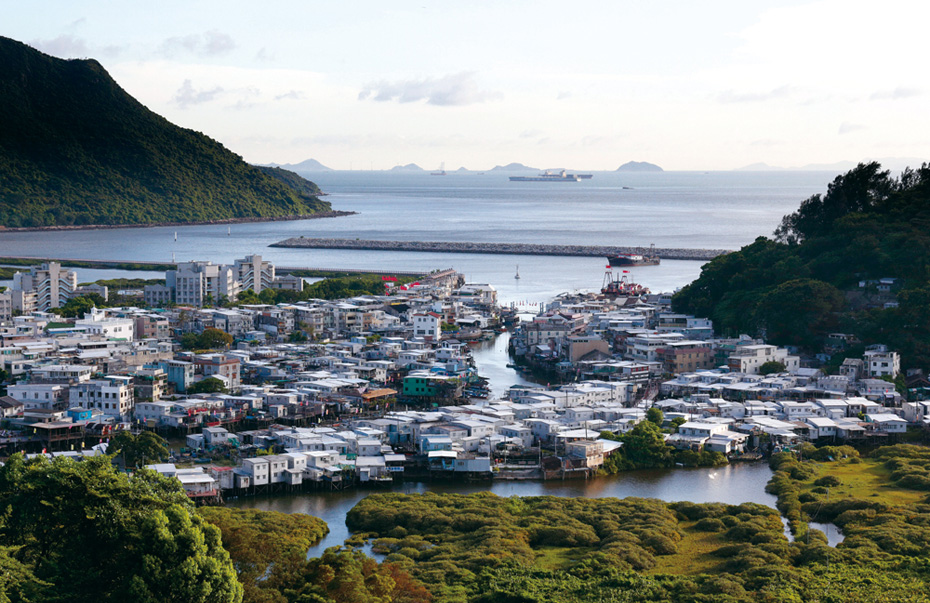Text | Shum Si
Photo | Hulu Culture, Shum Si, GRS, ISD, Tai O Heritage Hotel
Lantau Island covers an area of 147 square kilometres and is part of the Islands District in New Territories, with the north-eastern part of the island assigned to Tsuen Wan District.
Archaeological excavations tell us that the island was first inhabited more than 5,000 years ago in the middle of the Neolithic Age. The Baiyue people in turn resided here between 1500 BC and the Song Dynasty (9601279). Yudi Jisheng (“Gazetteer of Public Lands”, 1227) notes, “Mount Daxi: these are 36 islands in the sea, with residents living on fish and salt [making] (...)”. Lantau, or Dayu Shan/Daaih Yù Sāan (“Great Island Hill”) in contemporary Chinese, used to be called Daxi Shan/Daaih Hàih Sāan , for “Great Slave Hill”.
Lantau had been a major saltern in Guangdong since the Han (206 BC-220 AD) and Tang (618907) dynasties. Table salt was an important source of tax revenue for the nation, and the government had draconian controls over its production and sale. But salt bootlegging, ever a licence to print money, boomed despite the ban. In 1197 (third year of Qingyuan reign, Southern Song dynasty), salt makers rioted on Lantau, and the court sent in troops to kill every last islander. Records show that the court conferred honours on the demigods Tin Hau (Mazu) and Hung Shing (Hong Hei) for their part in quelling the incident.
Li Maoying’s Fief
Kangxi’s Xin’an xian zhi (“Xin’an County Gazetteer”, 1688) reads: “Mount Daxi (…) aka Mount Dayu: (…) more than ten villages sit at the foot of the mountain, with many salt pans. Fief of Li Wenjian from the Song dynasty to the present.”
Li Wenjian, aka Li Maoying (1201-1257), was a native of Panyu, Guangdong in the Song dynasty who obtained third place (tanhua ) in his palace examination and became the edict attendant of the Dragon Image (Longtu ) Chamber and the deputy minister of civil service affairs. He was made Dynasty-founding Baron of Panyu (kaiguo nan ) with a fiefdom of 300 households. According to the Ming-dynasty “Li Zhongjian (Gong) hui chengci fou citian ji ” [Account of Mr Li Zhongjian’s Induction into the City Temple and the Re-conferral of Fiefs], “The gentleman was made Dynasty-founding Baron of Panyu, and was conferred seven fiefs with some thousand qing [totalling 67 km2] of fields endowed. Among them is Daxi, Xin’an.
Today, you can still see inscriptions about Li in Mui Wo; Hau Wong Temple, Tung Chung; Pak Kung Temple, Sha Lo Wan; and Kwan Tai Temple, Tai O among other places, indicating that Li’s descendants still held Lantau land in the Qing dynasty.
Place names and villages on Lantau Island
The contemporary Chinese name for Lantau Island was first published in the Linghai yutu (“Public Maps of the Nanling coasts”, 1542/21st year of Jiajing reign, Ming dynasty). An entry in the 1819 (24th year, Jiaqing era, Qing dynasty) compilation of Xin’an County Gazetteer reads, “Mount Daxi, aka Mount Dayu”. This name has since entered common usage.
The 16th-century “Guangdong yanhai tu ” in Yue Daji (“Coastal map of Guangdong”, Records of Guangdong) marks eight villages on the island, namely Mui Wo, Lòh Būi Ou (i.e. Pui O), Tong Fuk, Dūng Sāi Chūng (i.e. Tung Chung and Sai Chung), Daaih Hòuh Sāan (i.e. Tai Ho), Shek Pik, Sha Lo Wan, and Tai O. All exist to this day.
According to government records, there were 35 villages and 7,310 residents on Lantau Island when the New Territories was leased to the United Kingdom in 1898, including 3,000 in Tai O, 1,000 in Ling Pei (now Tung Chung), and 700 in Mui Wo. The economy was dominated by fishing, agriculture, salt making, and firewood. The census of 1931 tallied 7,400-odd residents, with barely any population growth.
Lantau Island now comprises Tung Chung New Town and other heung (“rurality”) such as Tung Chung, Tai O, Mu Wo and Lantau South.
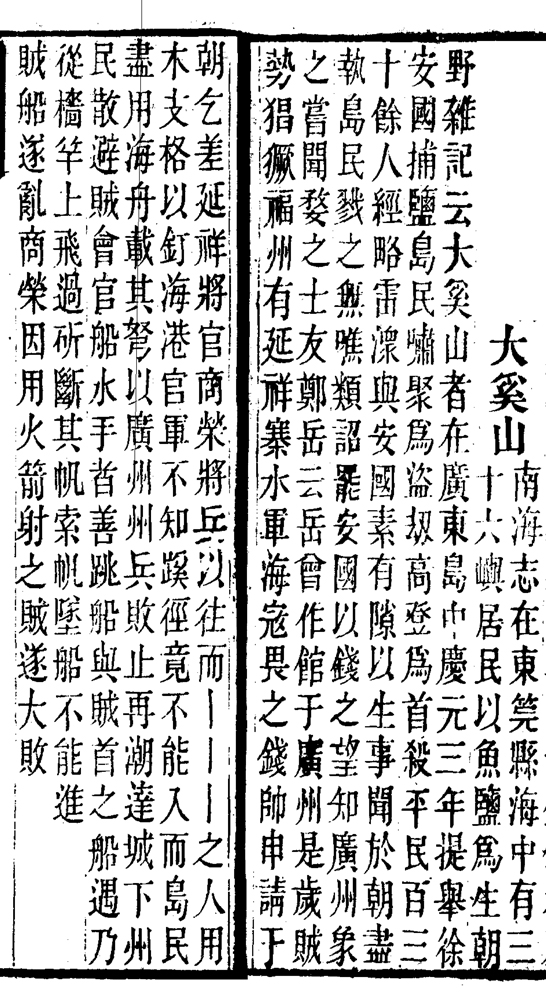
In “Yu Dei Gei Sing”, description of Dai Hai Shan, i.e. today's Lantau Island.
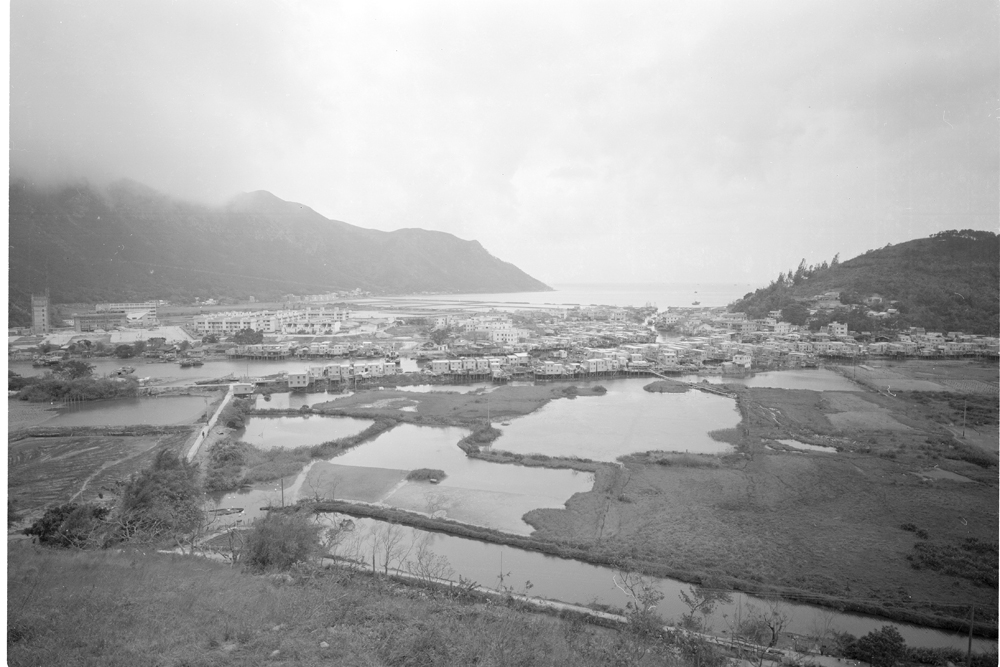
The small villages on Lantau Island were sparsely populated in the old days. Tai O is the place which has the highest population.
Buddhist zen forest
In central Lantau spanning from Lantau Peak (aka Fung Wong Shan) to Ling Wui Shan lie Ngong Ping, Luk Wu, Keung Shan, Tei Tong Tsai and other vales. As the Qing dynasty drew to a close, these locations hosted the first “Brahmic residences”. The unstable political scene in the early Republican era drew many southbound monks and nuns, mendicants and renunciates alike, to “the exquisite scenery of an ambiance thick with strength”. The 1957 Dayushan Zhi (Lantau gazetteer) notes there were more than 80 temples and “quiet rooms” or sanctuaries in Ngong Ping, Luk Wu, Keung Shan, Tei Tong Tsai and elsewhere, and the spots earned a moniker as the four Buddhist woods of Lantau. Among the more famous ones are Chuk Yuen Ching She in Luk Wu; Luk Wu Ching She; Fat Lam and Po Lam Monaster y in Tei Tong Tsai; Ling Yan Monastery and Kwun Yam Temple in Keung Shan; Po Lin Monastery and Po Ming Temple (Puming Chanyuan ) in Ngong Ping. For want of new abbots, many of these monasteries have since ceased organising public activities.
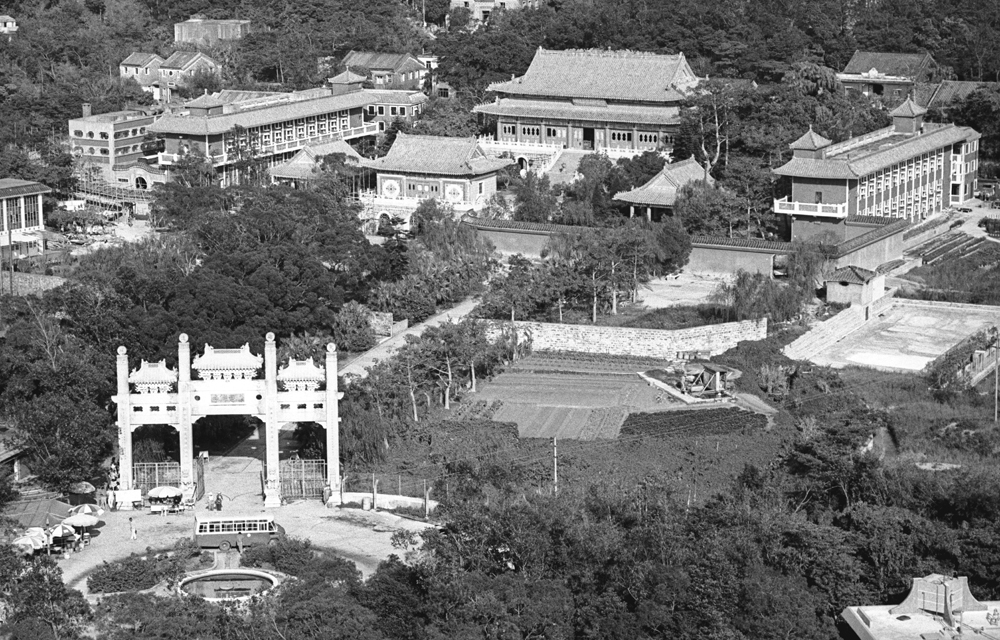
Po Lin Monastery in 1960s with a solemn appearance, is a major Buddhist shrine in Hong Kong.
Po Lin Monastery
In 1906, three Chan (Zen) Buddhist abbot s came to Ngong Ping, Lantau. The Venerable Da Yue, Dun Xiu, and Yue Ming saw that “the plateau, half a mile up, is surrounded by mountains on four sides and worthy of being a place of awakening for the world”, duly clearing the ground to build a big thatched hut. “Yunshui ” mendicants indeed came from all directions as the monastery grew from strength to strength with these “monks of cloud and water”. In 1924, it was officially named Po Lin Monastery, and this “treasured lotus”, under the direction of incoming abbots Ji Xiu and Fa Ke, became Hong Kong’s largest Buddhist Shifang Conglin -managed institution.
In late 1993, the 26-metre tall (seated) “Big Buddha” or Tian Tan Buddha became the second largest outdoor bronze Buddha in the world (at the time of opening) and put Ngong Ping on the global tourist map. The Ngong Ping 360 gondola lift, opened in 2006, now whisks visitors up the monastery with ease.
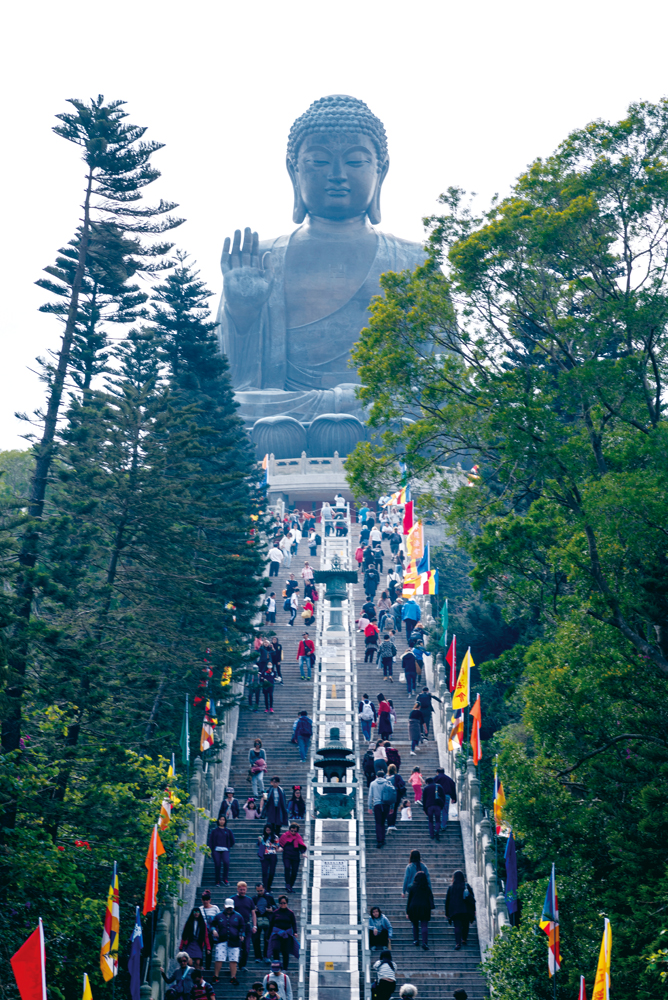
Tian Tan Big Buddha, constructed in 1993, is the second largest outdoor bronze Buddha statue and has long been a famous tourist spot.
Lantau Mountain Camp on Sunset Peak
Between 1925 and 1935, some foreigners set their sights on a highland spot between Sunset Peak (aka Tai Tung Shan) and Yi Tung Shan and applied to the government for the construction of twelve stone huts. The “Lantau Mountain Camp” or Lan Tau Ying was to be run for holidaymakers and retreat seekers.
When Hong Kong fell to the Japanese, all but two buildings were demolished. After the city was liberated, the Lantau Mountain Camp Association resumed constructing 43 holiday cottages with kitchens, reservoirs, management staff quarters, restaurants and other equipment. The camps remain in private hands to this day, with several managed by religious groups.
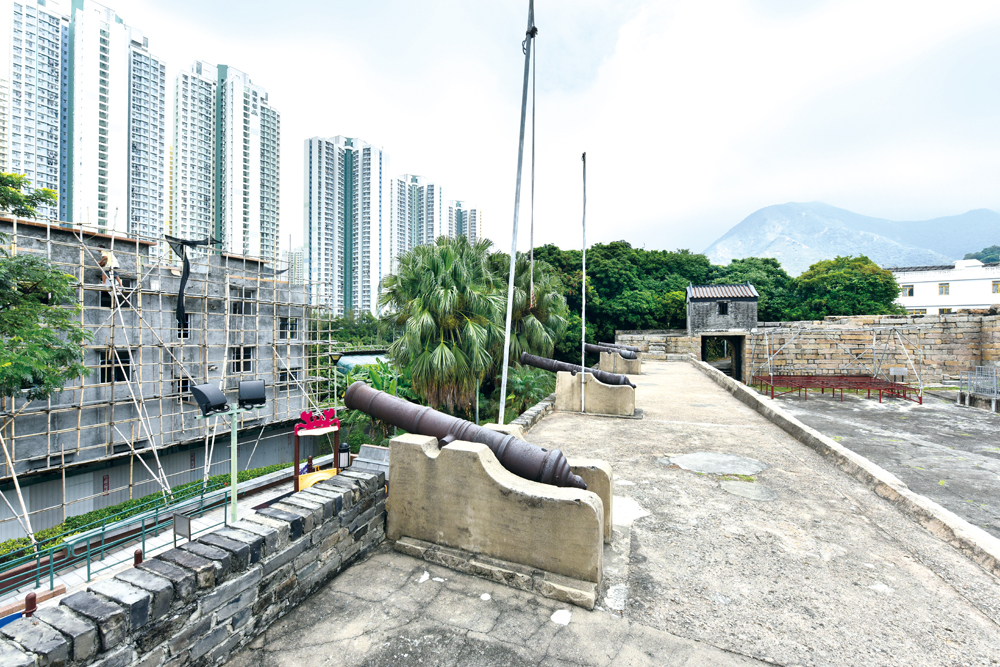
During the last ten years or more, Tung Chung has experienced rapid development; many large housing estates have been built in the neighbourhood of Tung Chung Fort.
Statutory Monuments on Lantau Island
Rock Carving at Shek Pik, Lantau Island
The geometric patterns, composed of spiralling squares and circles, suggest that the carving was made by locals during the Bronze Age over 3,000 years ago. Many similar carvings were found in Hong Kong, Macau, and Zhuhai.
The fort (paau tòih, aka só sìhng ) was an encampment of the Right Regiment, Dapeng Brigade in the Qing dynasty. The inscription “12th year of the Daoguang reign” (1832) was engraved on its front gate, and six ancient cannons remain in the fort.
Fan Lau Fort
Aka Kai Yik Kok (“Chicken Wing Fort”), it was built in 1722 in the final year of Kangxi’s reign during the Qing dynasty, with eight guns and twenty barracks rooms. The court built 41 such forts along the Guangdong coast, and Hong Kong has another one called Fat Tong Mun Fort (now Tung Lung Fort).
Stone Circle at Fan Lau
Said to have been made in the late Neolithic and early Bronze Age, this uncar ved stone appeared to have been deliberately stacked. Archaeologists believe that this circle may be related to ritual ceremonies.
Tung Chung Battery
In 1817 (22nd year, Jiaqing era), it was built as a “minor battery at the Tung Chung river mouth”, with 30 xunfang patrol and defence members stationed.
Yeung Hau Temple, Tai O
One of the historic temples in Tai O, holding an iron bell cast in the 38th year of the Kangxi era (1699). Exquisite Shiwan ceramic figurines sit on the roof ridge of the entrance hall and the two parapet walls of the covered courtyard.
Hong Kong Entry in China’s National List of Intangible Cultural Heritage
“Tai O Dragon Boat Water Parade”
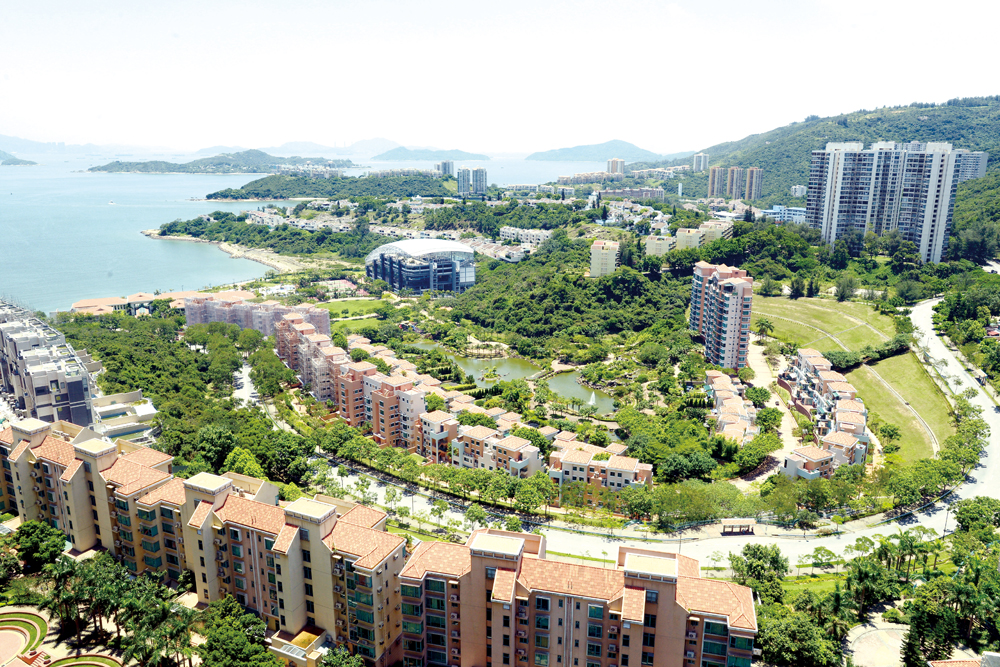
Discovery Bay, built in early 1980s, is located at the north-eastern side of Lantau Island. It is the first large housing estate built by a private property developer on Lantau Island.
Lantau Festival
Tai O: Birthdays of Guandi (Kwan Tai) and Guanyin (Kwun Yam). At Bun Louh Pàahng : Fuk Tak Shrine. At Tsan Lung She: birthdays of Hung Shing, Kwan Tai; jiao for Chu Tai-sin; birthday of Hua Guang and Yeung Hau; birthday for Tin Hau at Fan Lau, and Yu Lan “Ghost Festival” by the land and sea residents of Tai O, among others.
Sha Lo Wan: Birthday of Hung Shing.
Mui Wo: Bir thdays of Hung Shing and Man Mo Yi Tai: Wenchang, Civil God of Culture and Literature, and Kwan Tai, Martial God.
Tung Chung: Birthday of Yeung Hau.
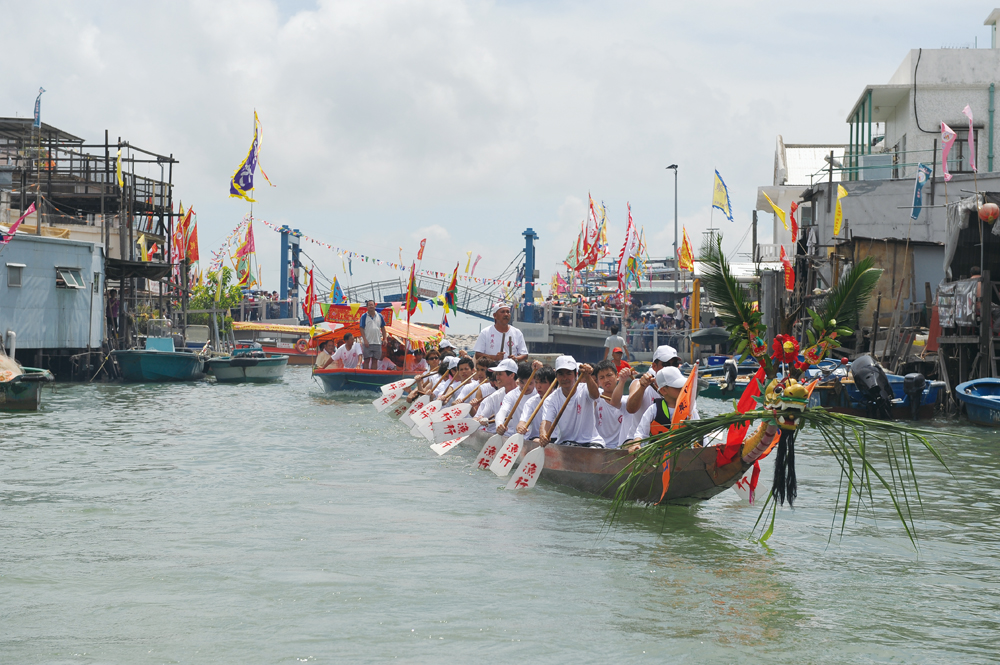
Tai O Dragon Boat Water Parade.
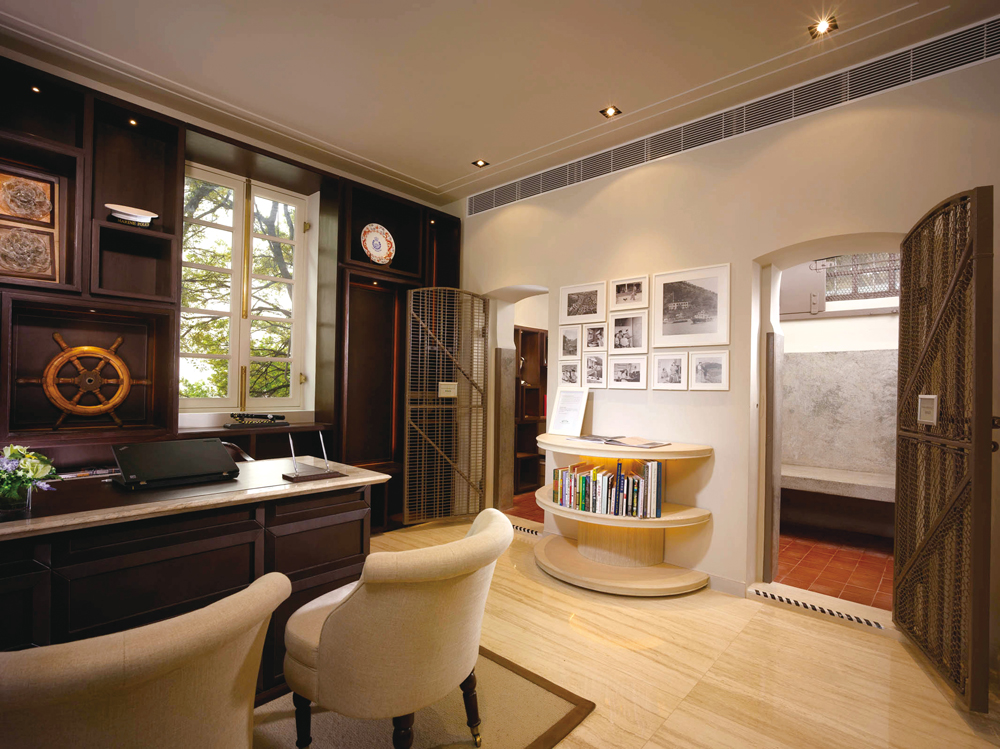
Former Tai O Police Station which has become Tai O Heritage Hotel after being revitalized, has a special architectural style. (Photo courtesy of Tai O Heritage Hotel)
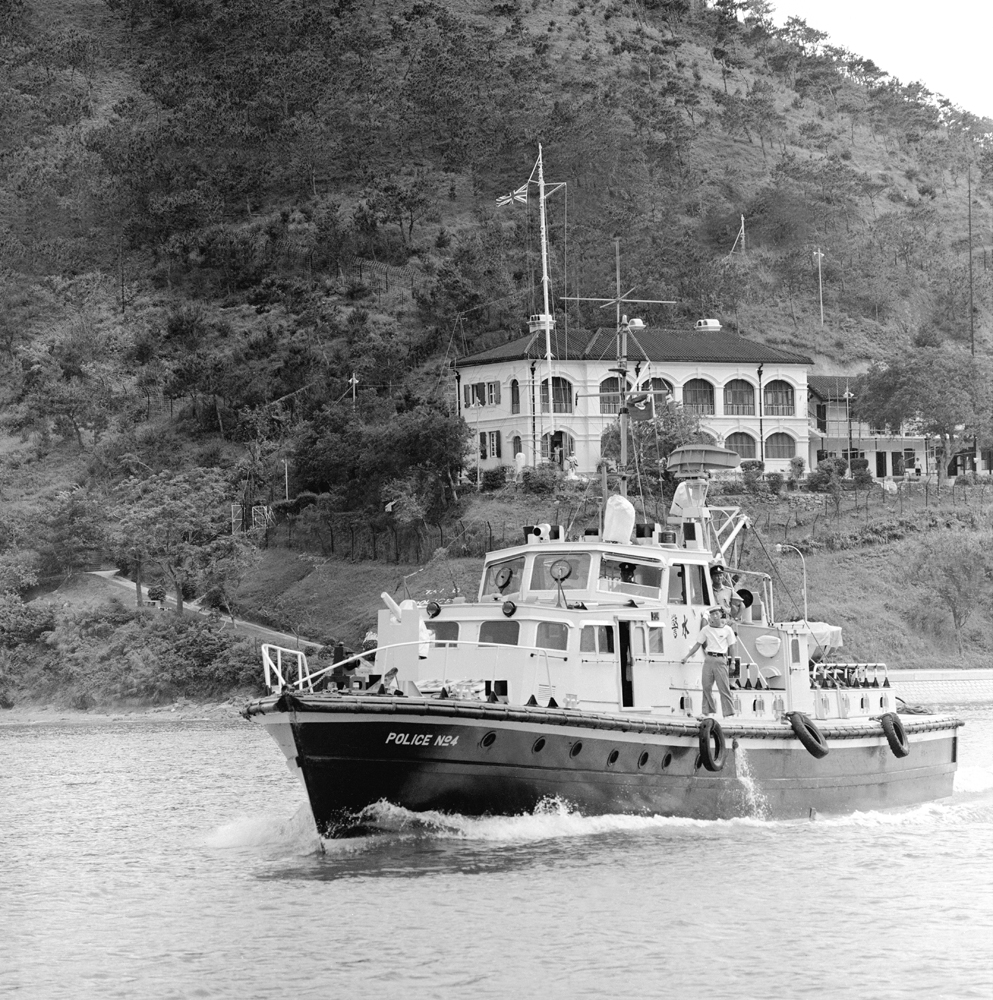
Tai O Police Station in the early days played the role of keeping the law and order of both the land and the sea in Tai O.




